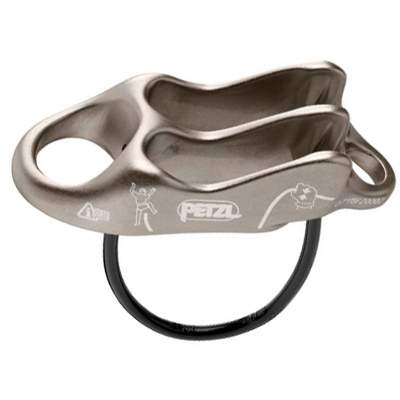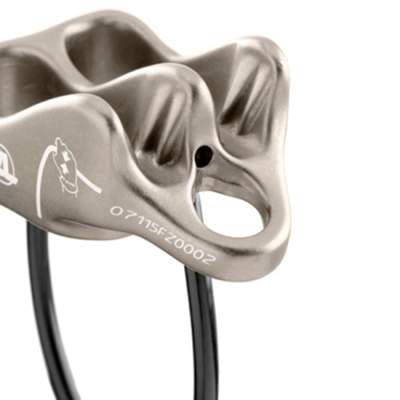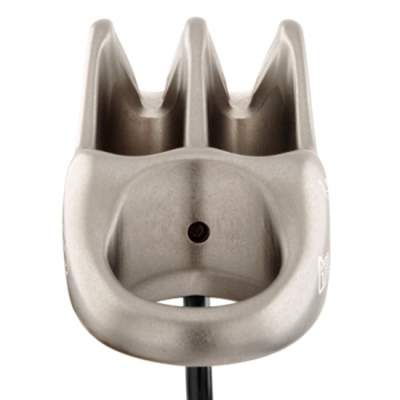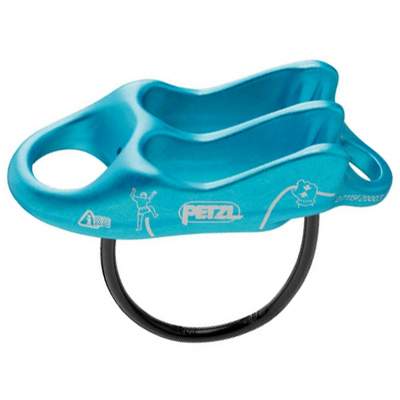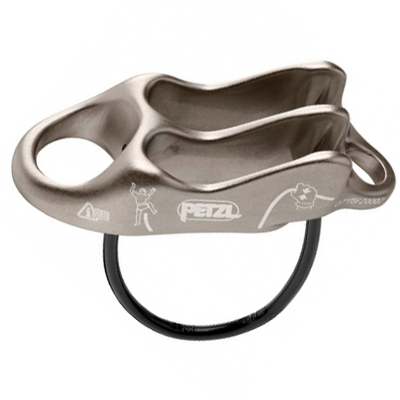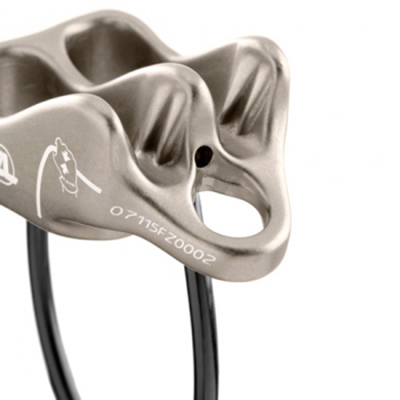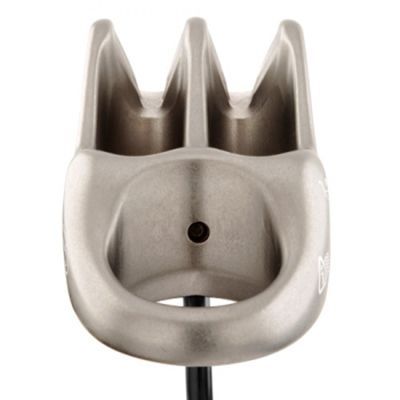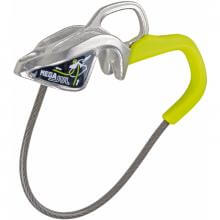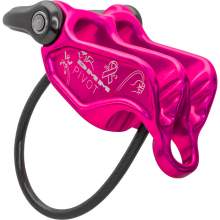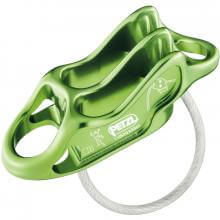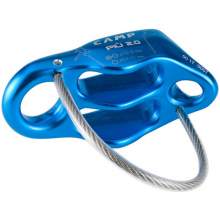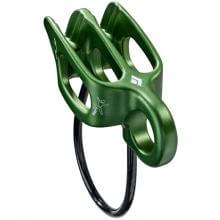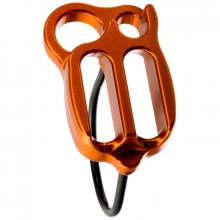Reverso 3
Description
This multi-purpose belay/rappel device is lightweight and easy to use. The asymmetrical V-shaped grooved friction channels adapt the friction for better control using our ARC (Adaptive Rope Control) technology.
Ultra-light design:
- minimalist construction
- hot-forged aluminum
- weight: 77 g
A single device for all rope types:
- effective braking on half and twin ropes ≥ 7.5 mm
- effective braking on single ropes ≥ 8.9 mm
- can belay the leader, one or two seconding climbers and can be used for rappelling
- independent and simultaneous belaying of one or two seconding climbers in Reverso mode
- quick changeovers from Reverso mode to belaying the leader when climbing multi-pitch routes
V-shaped friction channels:
- increased friction on thin ropes
- friction is adapted for larger diameter ropes
- increases the locking pressure on the ropes in Reverso Mode
Asymmetrically grooved sidewalls:
- increased braking power during a leader or top rope fall or while rappelling
- rope smoothly slides through device when taking up slack
Carabiner hole to release device when loaded in Reverso mode: allows the loaded device in Reverso mode to be easily and gradually released with only a carabiner
Rope friendly, facilitates belay and rope handling:
- will not kink the ropes regardless of the mode used
- separates the two strands of rope when belaying and rappelling
Intuitive use:
- Reverso mode attachment point is easy to identify
- keeper cable keeps the device from moving up the rope when belaying and reduces chances of losing the device
- usage diagrams (standard belay and Reverso modes) engraved on device
Use with symmetrical shaped locking carabiners (Am'D or OK) to maximize efficiency no matter which end is closest to the device
Retail price
This Product is Hard to Find.
We don’t know where you can buy this item online in the US. We’ll continue to check all the major retailers and will update this page as soon as we find one.
If you know where to find this online in the US, let us know, and we’ll add the link.
Device Type  Device TypeTubeThe most commonly used belay type also called an “ATC” or “tuber.” Other than a distinction between other belay device types, “Tube” is a rarely used term, most climbers just assume you're talking about this style when they refer to your "belay device." 
Figure 8Mostly used in rescue, canyoneering, tactical, work safety, or by old school climbers and rappellers. One reason they went out of popularity with recreational climbers is because they tend to create twists in the rope. 
Brake AssistThese devices assist in stopping the rope when a climber falls or hangs on the rope. 
Often referred to as “auto-blocking” but that’s not the official terminology because no belay device should be assumed to work automatically by itself, even if it feels like it does (or does most the time). PlateWhen simplicity is a must, or you started climbing before Tubers were the norm. Bonus: They tend to be very light weight. 
DescenderFor rappelling, not for belaying a lead climber or top-roping. 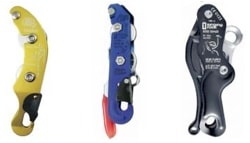 |
Tube |
Weight (g)  Weight (g)In grams, the weight, as stated by the manufacturer/brand. |
77 g |
Belay Brake Assist  Belay Brake AssistThis is when the belay device significantly reduces the amount of holding power the belayer must exert to stop a fall and hold a climber. This is also called "assisted-braking" as the device must hold a significant amount of the climber’s weight; this term does not include friction-adding "teeth" found on some tube style belay devices. Confusingly referred to as “auto-blocking” or “auto-locking” these terms wrongly imply the device will always, automatically, stop a fall or hold a climber even if the belayer/rappeller is hands-free. These devices are not meant to be used without a hand on the braking side of the rope; the belayers/rapppeller brake hand should always be on the brake rope. Worth ConsideringMost of the mechanical brake assist devices only hold a single strand of rope and are not capable of double-strand rappelling (the most common method of rappel). |
No |
| Rope Options | 1 or 2 ropes |
Guide Mode  Guide ModeThis is when you belay directly off the anchor instead of your harness. Guide mode is helpful if you climb outdoors a lot because it reduces the holding power required from the belayer. When your partner falls or rests, the weight of the climber is held mostly by the anchor and the belay device. Tubers and PlatesWhen belaying in "guide mode," the tubers and plates turn auto-blocking. During a fall, the climbing rope pinches the slack rope, completely stopping the movement of either rope. A common guide mode setup shown below. 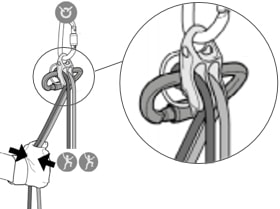
Mechanical Brake Assist DevicesThere is no difference in the functionality of the device. A brake-hand should always be on the rope to ensure the climber is caught in the case of a fall. A common guide mode setup shown below. 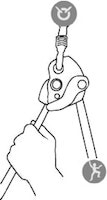
Where guide mode is used
Learn Morehttp://www.climbing.com/skill/essential-skills-auto-blocking-belay-devices/ |
Up to 2 followers |
Teeth  TeethTeeth are only seen on tube devices. They add friction that helps grip the rope for more belaying control. This is helpful for belaying heavier climbers. Teeth are becoming standard on new tube devices. 
Worth ConsideringTeeth do wear out. You can limit wear by rappelling on the side without teeth (if you don’t need the extra friction). Once they’re worn, you’ll still have a usable belay device, just less friction. |
Yes |
Rope Range (mm)  Rope Range (mm)The range of rope diameters, in millimeters, that the manufacturer/brand specifies can safely be used. This is the best case scenario and does not necessarily take into consideration that certified ropes have a tolerance of +/- .3 mm. Recently, manufacturers have started to add an "optimized" rope range -- this is the range that will result in the nicest handling of the belay device. | 7.5 mm
- 11.0 mm
single: 8.9 - 11.0 half: 8.0 - 11.0 twin: 7.5 - 11.0 |
Certification  CertificationsThe main climbing gear certifications are CE and UIAA--and normally the UIAA creates the rules that the CE body also supports. When possible, we try to list all the certifications the product carries. To sell a climbing product in Europe, the device must be CE certified. There are no official requirements to sell climbing gear in the US. The UIAA certification is a voluntary process. Learn MoreRock and Ice Certifications Guide |
|
No reviews yet.
So should you throw away your old devices and buy this one? No, of course not you greedy American! Those things work fine and you should keep them until they wear out. But if you are in the market for a new belay device, the Reverso 3 is the one I’d go with for sure.
Overall, I really like the Reverso3 and only have a few minor complaints. The Reverso 3 doesn’t top belay as well with ropes fatter than 10 mm. This doesn’t effect me that much I usually use ropes between 9.4 and 9.8 but it is worth mentioning since I have had trouble with partners’ ropes. Secondly, my Reverso3 only lasted a year before the edges became fairly sharp (like previous models) and I no longer felt comfortable using it for belaying. As I said before this is probably reasonable since I used it for so many pitches, especially for rappelling, which causes the most wear.
The Reverso3 really proved its worth when we were rapping cloud tower. The new friction slots allow for the Reverso3 to really grab thinner ropes. We were rapping with our lead line, a 9.5 mm Ion and the beal 8mm trail line and had no problem controlling our speed. The Reverso did a great job on the 8mm and we saw very little slippage a nice change for me from the previous generation. I was even able to do a single strand rap on the 8mm rope without having to redirect the rope to add friction. Also of note the Reverso still rappels well on larger diameter ropes.
Warning: This video is dubbed in English. If you're getting antsy, skip to section 7:40-8:15 for one of the most interesting parts, where they show a hardware specific camera inspection.

